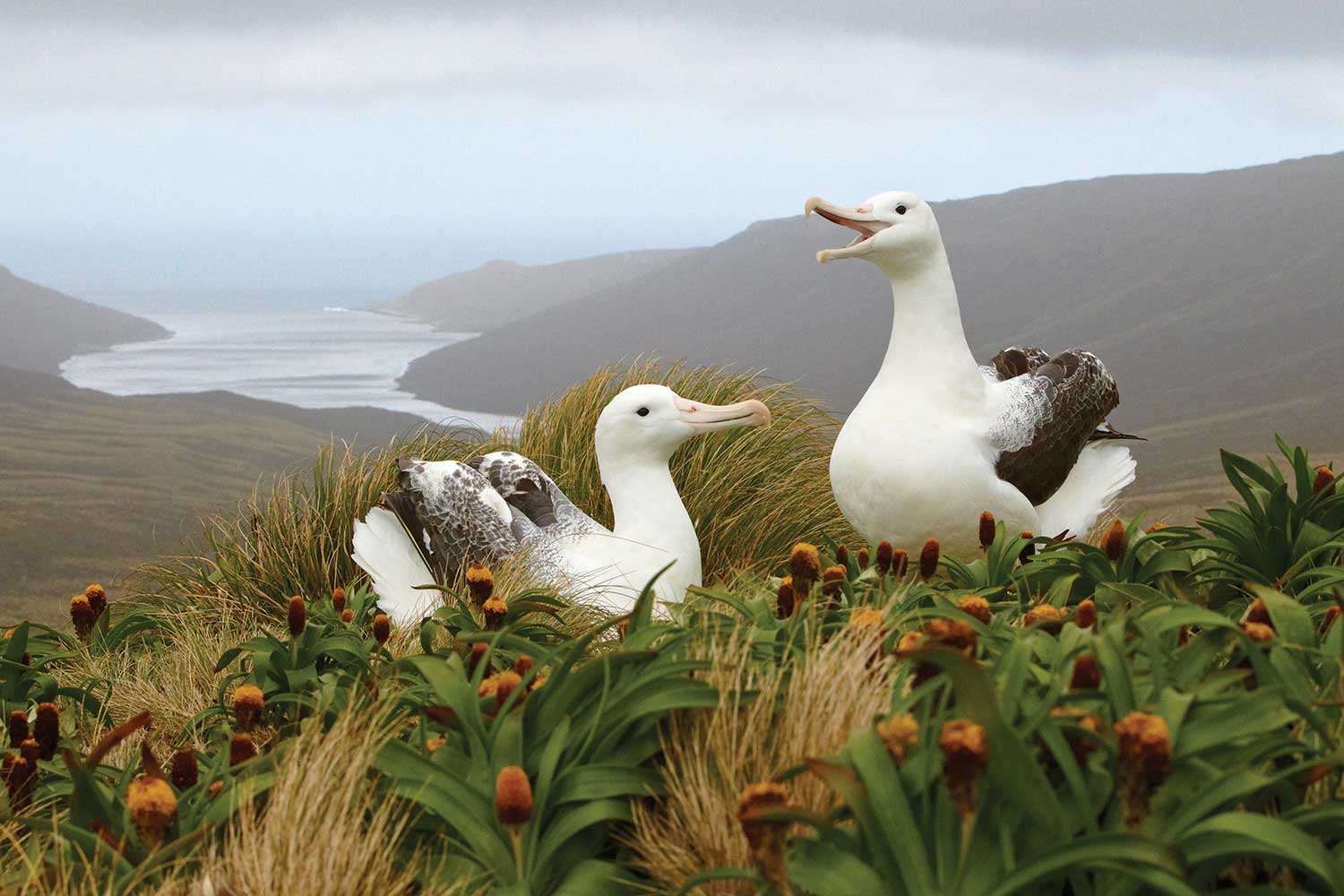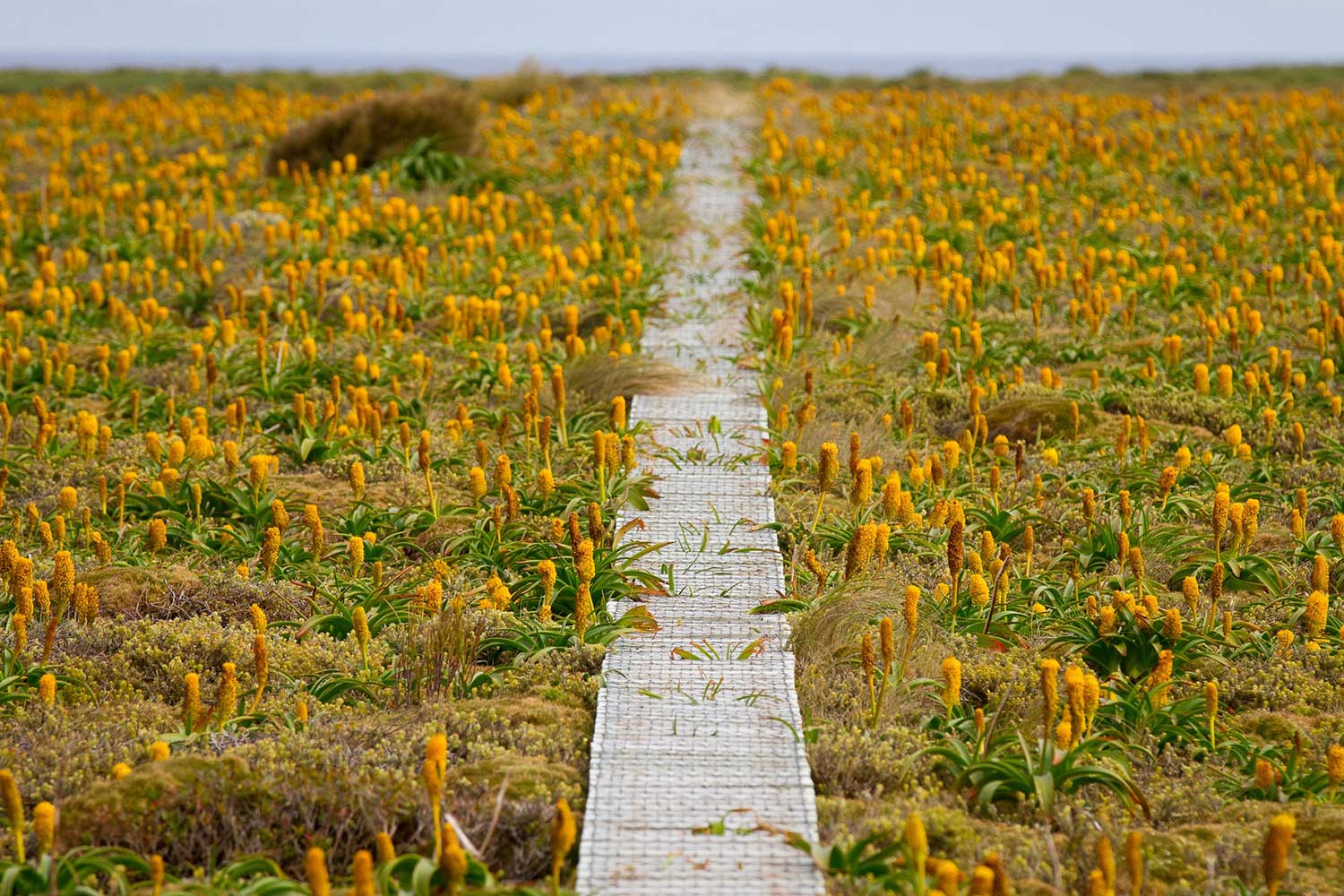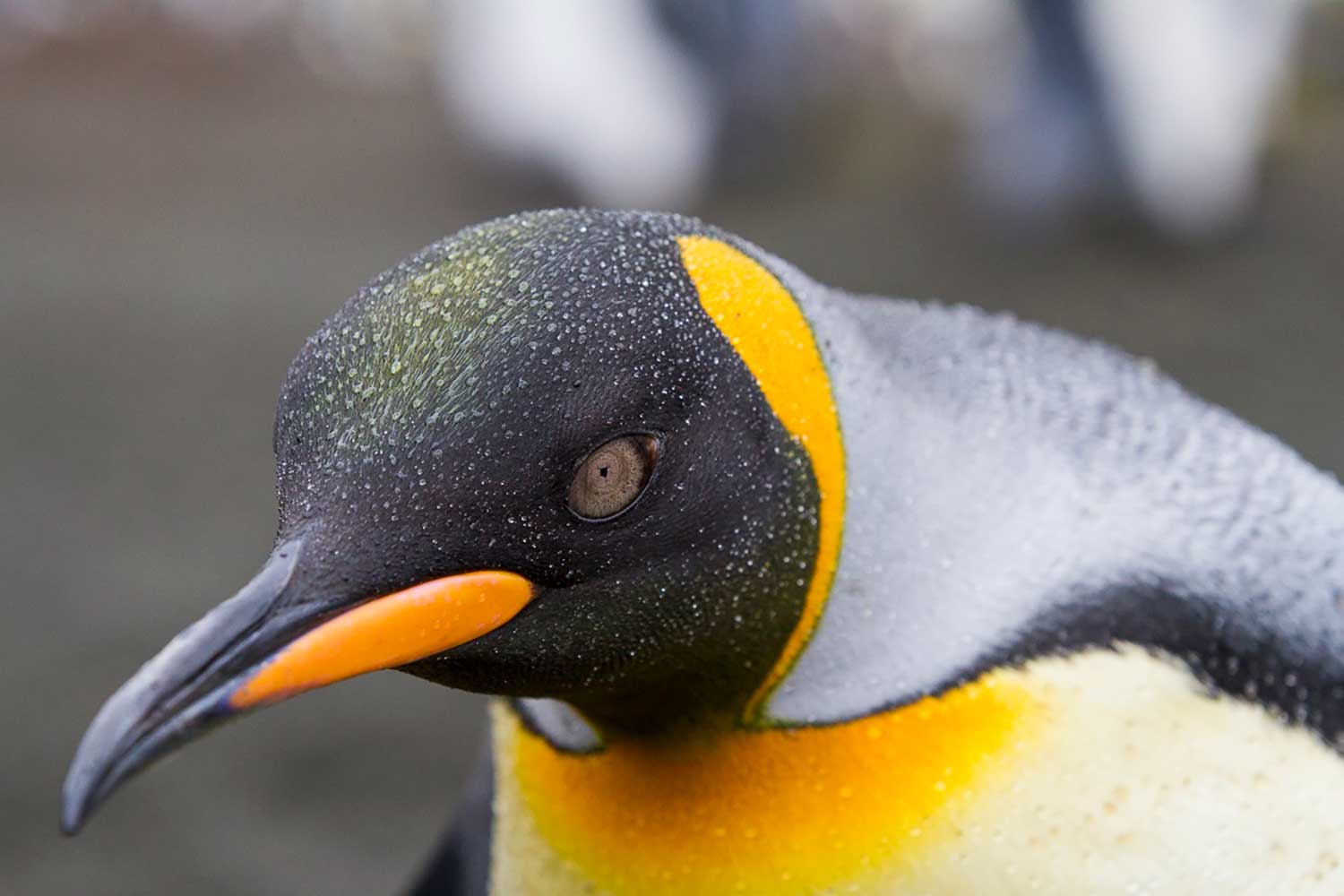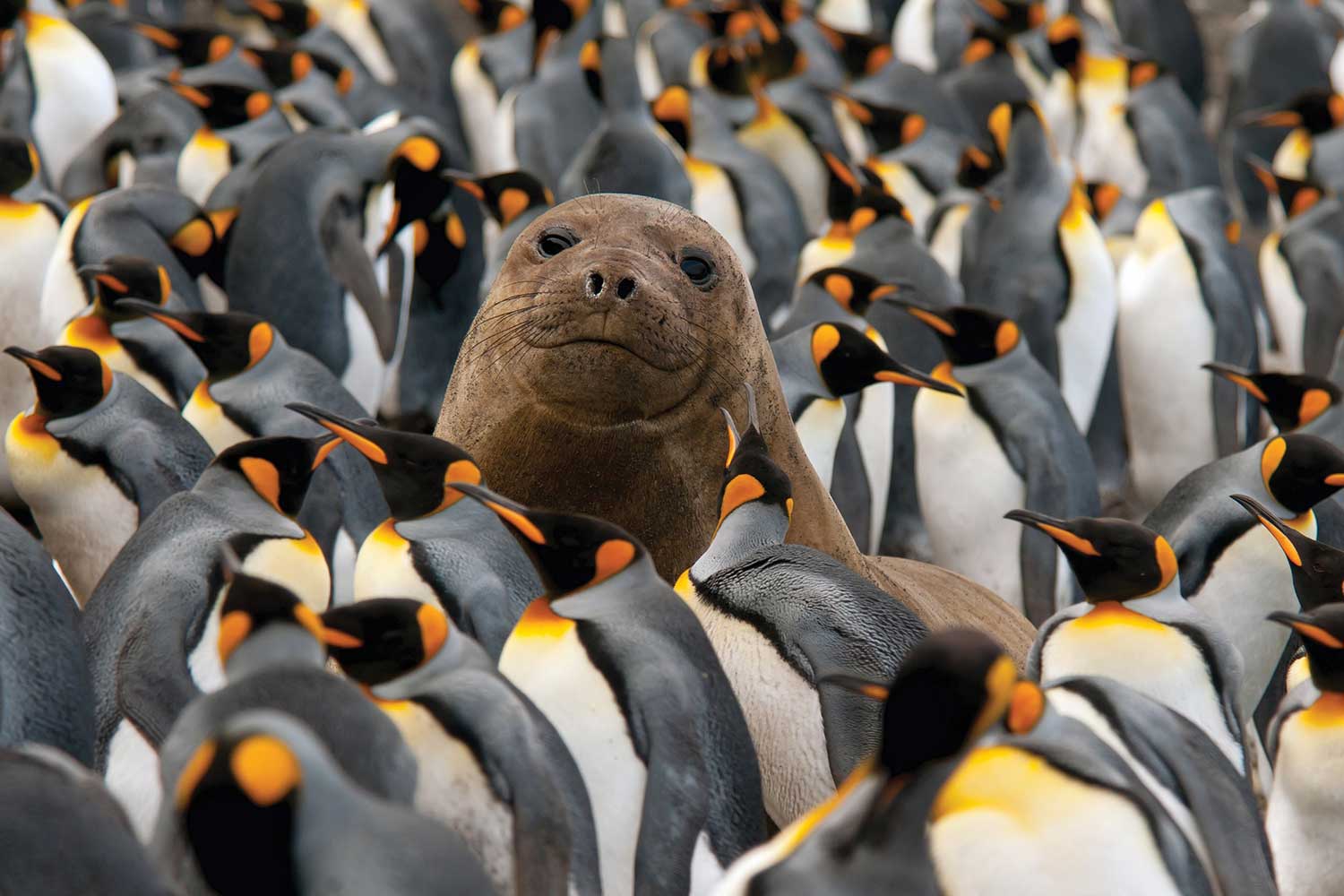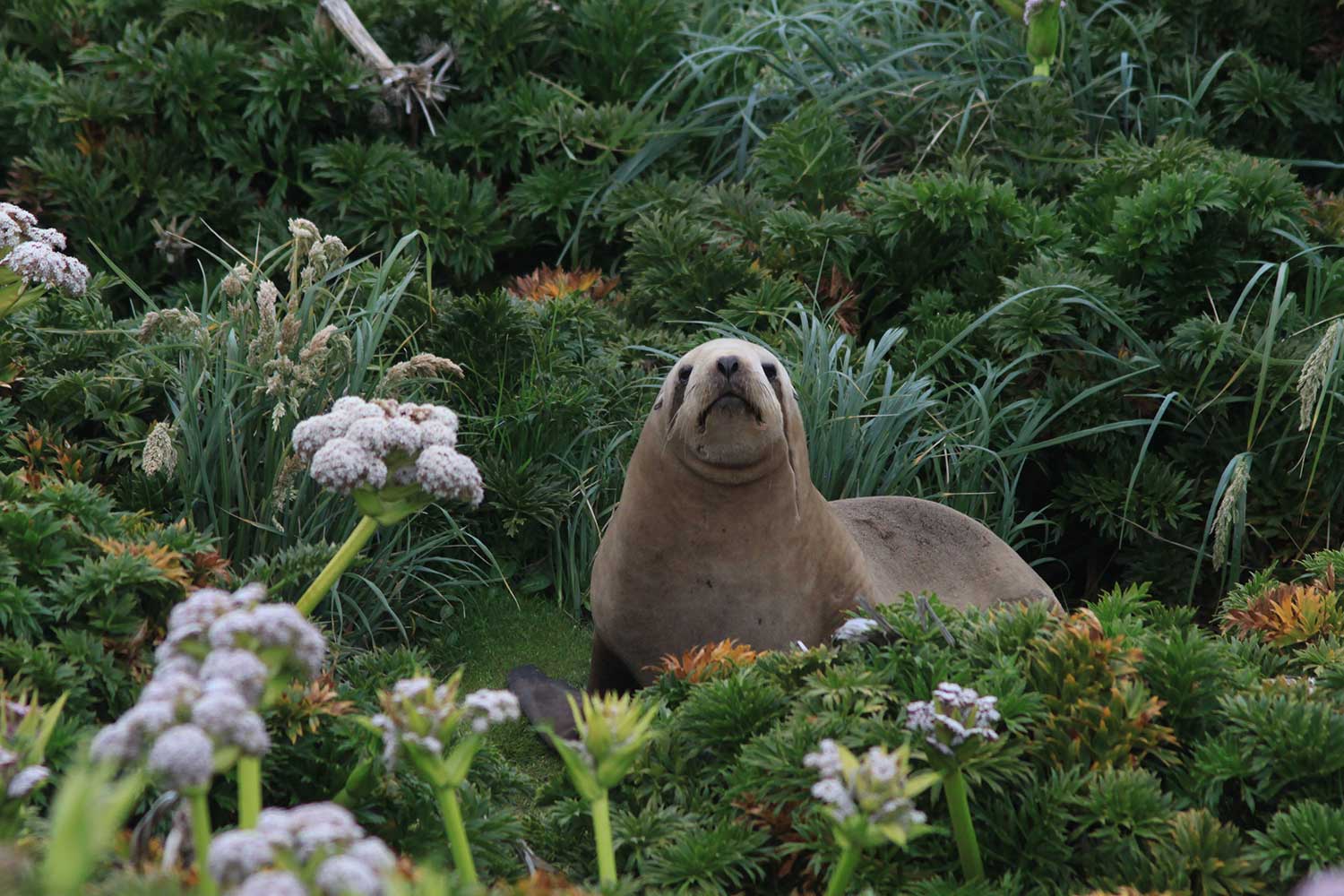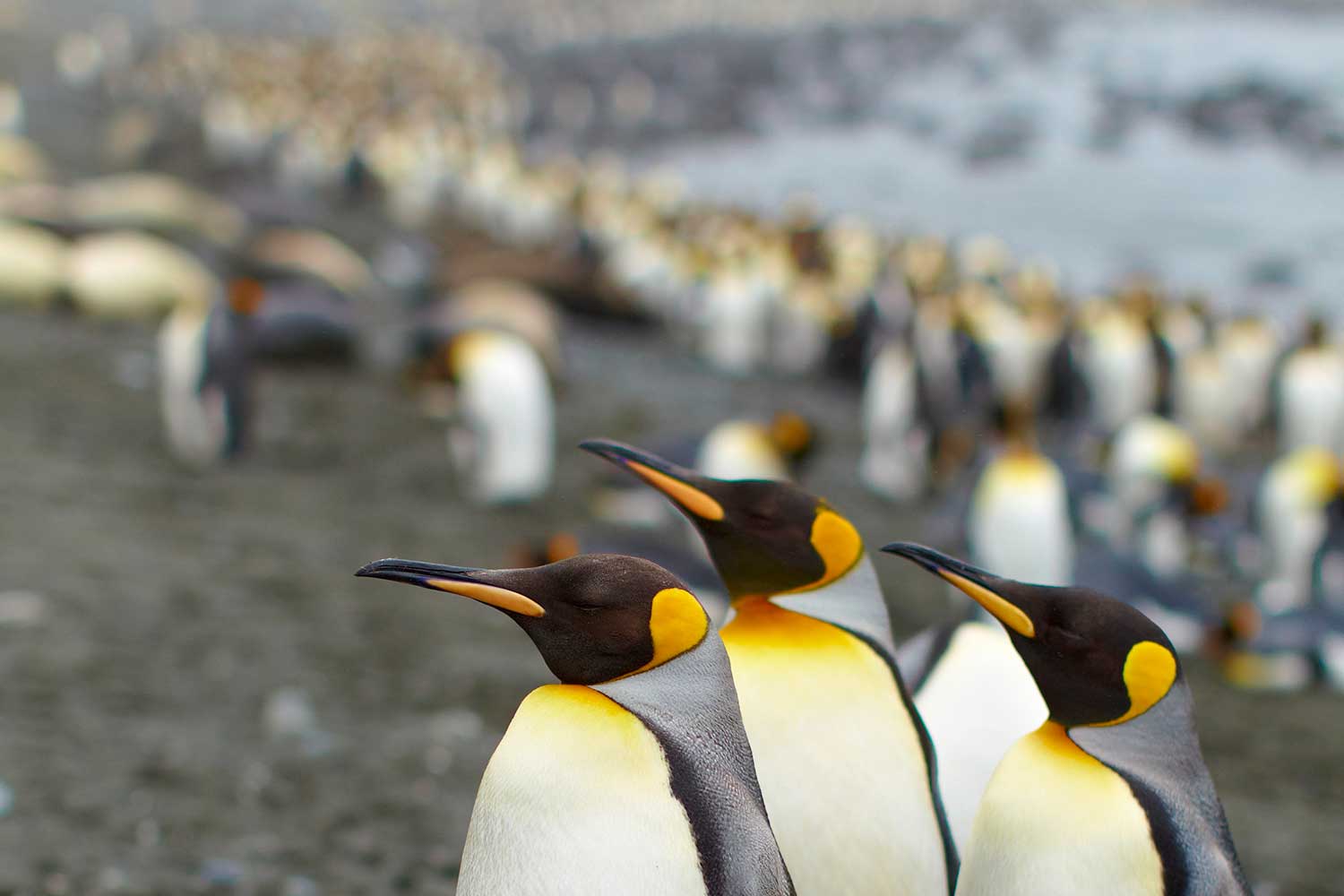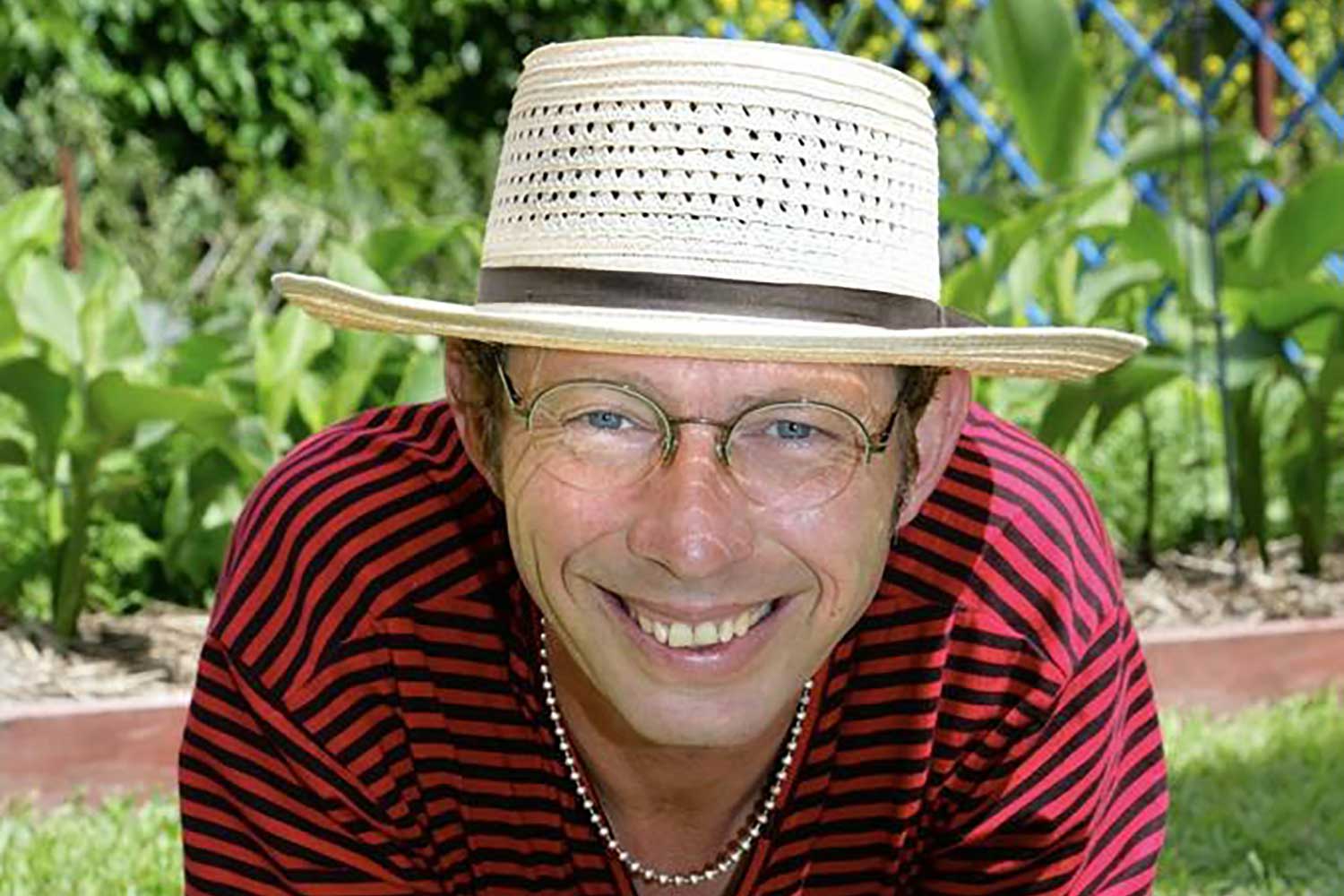Megaherbs of the Subantarctic with Jerry Coleby-Williams
Megaherbs of the Subantarctic
with Jerry Coleby-Williams
Giant carrots, dwarf daisy bush, endemic lilies, and miniature orchids: collectively, the islands we will visit are recognised as a world centre for diversity and are home to some of the most curious plants on Earth.
While botanically unrelated, megaherbs are perennial that have evolved to extreme proportions under the influence of ever-present, saline winds and sea spray from the storm wracked South Pacific. Exposure means it is too extreme for tall trees. Instead, it is believed that large, fleshy leaves and dense plant growth of these perennials are partly an evolutionary response to saline winds, and partly to improve the capture of sunlight for growth at these gloomy latitudes.
Forming a cottage garden landscape around a metre or so high, the subantarctic megaherbs burst into a stunning floral display. Why the colour when there are no bees or butterflies? Around 100 species of moth, a third of which are endemic to the region we are visiting, are effective pollinators along with flies. These insects, plus the ever present wind, ensure pollination.
Despite our warming climate, sub-zero frosts are a new threat. Frost kills foliage, opening up the protective canopy to desiccation, further frost damage, and dieback. That said, sustained effort has freed these islands from the ravages of introduced vermin, like cats, rats and rabbits and these remote biodiversity hot spots are recovering well.
Sir Joseph Hooker, a former botanist, explorer and Director of the Royal Botanic Gardens, Kew (my alma mater) described this unexpectedly lush and colourful megaherb phenomenon as ‘second to none outside the tropics’.
Grab your wellies and fasten your rain jacket for an unforgettable blast of nature few will ever see!

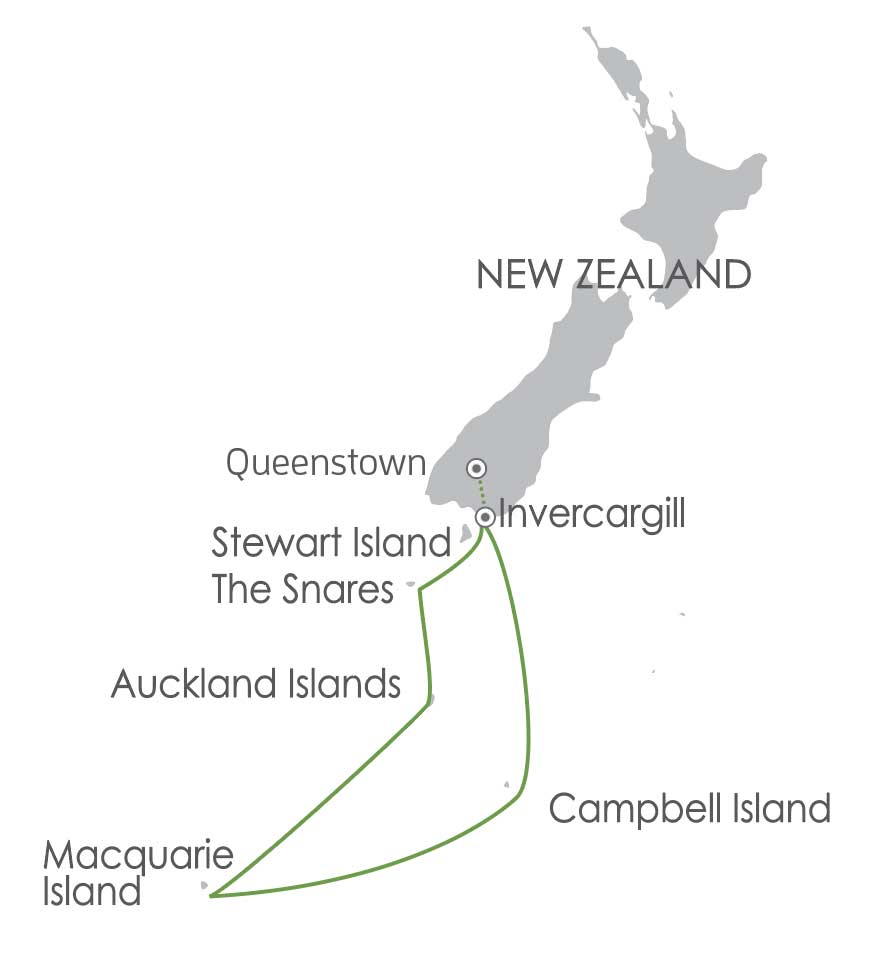
12 Days / 11 Nights
- *$17,965 Per Person Superior Twin (Deck 5)
- *$20,850 Per Person Main Deck Single
WEDNESDAY 26 NOVEMBER 2025
QUEENSTOWN
Welcome to Aotearoa – the Land of the Long White Cloud.
Upon arrival at Queenstown International Airport you will be transferred to the Millennium Hotel for an overnight stay.
There will be an informal get-together and dinner at the hotel this evening – giving you an opportunity to meet Jerry, fellow adventurers on your voyage and some of the Heritage Expeditions expedition team.
[Meal Included: Dinner]
THURSDAY 27 NOVEMBER 2025
PORT BLUFF
We’ll eat breakfast at the hotel before enjoying a leisurely morning in Queenstown – a picturesque resort town nestled on the shores of beautiful Lake Wakatipu and surrounded by the spectacular, snow-capped Southern Alps. After returning to the hotel for lunch, we will be transferred by coach to the Port of Bluff, near Invercargill, to board our ship the Heritage Adventurer.
The Heritage Adventurer is a true pioneering expedition vessel of exceptional pedigree. Purpose-built in Finland in 1991, and specifically designed for Polar exploration, she is often referred to as the ‘Grande Dame of Expedition Cruising’ due to her celebrated history and refined design.
Originally designed to accommodate 184 guests, the Heritage Adventurer now welcomes just 140 expeditioners, ensuring spacious, stylish, and comfortable voyages. Additionally, a fleet of 14 Zodiacs fully maximises the adventure with more opportunities for excursions and closer interactions with the natural environment.
Before pulling anchor, we will conduct a number of safety briefings, and you will also have time to settle into your cabin and familiarise yourself with the ship.
Feel free to join the expedition team in the Observation Lounge, or up on the Observation Deck – the bow will be pointed towards The Snares as we begin our botanical adventure to the Galapagos of the Southern Ocean.
[Meals Included: Breakfast, Lunch & Dinner]
FRIDAY 28 NOVEMBER 2025
THE SNARES – NORTH EAST ISLAND
The closest Subantarctic Islands to New Zealand, this chain of rocky islands and outcrops was aptly named The Snares as they were once considered a hazard for sailing ships.
Comprising of two main islands and a group of five smaller islands called the Western Chain, The Snares are uninhabited and enjoy the highest protection as Nature Reserves.
We plan to arrive in the morning, and as landings are not permitted on The Snares, we will Zodiac cruise along the sheltered eastern side of the main island if weather and sea conditions are suitable.
In the sheltered bays, we should see the endemic Snares crested penguin, Snares Island tomtit and fernbirds. There are hundreds of thousands of sooty shearwaters nesting on The Snares – the actual number is much debated – and Buller’s albatross breed here from early January onwards.
It is claimed by some that these islands are home to more nesting seabirds than all of the British Isles together.
From the Zodiacs there will be opportunities to view forests of the subantarctic tree daisy (Olearia lyallii) which forms a canopy over much of the island group. The species is endemic to The Snares and southern New Zealand, and has also established itself as an introduced species on the Auckland Islands, whence the type specimen was described.
Three other significant plant species are found on The Snares including Punui (Stilbocarpa robusta) which grows in only one other place; the endemic Snares Island’s anisotome (Anisotome acutifolia) and the highly threatened Cook’s scurvy grass (Lepidium oleraceum) – a cabbage relative, not a true grass.
[Meals Included: Breakfast, Lunch & Dinner]
SATURDAY 29 NOVEMBER 2025
AUCKLAND ISLANDS – ENDERBY ISLAND
The Auckland Islands group was formed by two volcanoes which erupted some 10-25 million years ago. They have subsequently been eroded and dissected by glaciation creating the archipelago as we know it today.
Enderby Island is the northernmost island in the archipelago and one of the most beautiful islands in this group. It is relatively easy to land on and walk around Enderby, making it an outstanding location for birding, wildlife viewing, and botanising.
The island was cleared of all introduced animals in 1994 and both birds and vegetation, especially the herbaceous plants, are recovering both in numbers and diversity.
Our plan is to land at Sandy Bay – one of three breeding areas in the Auckland Islands for the Hooker’s or New Zealand sea lion, a rare member of the seal family.
Beach-master bulls gather on the beach, defending their harems from younger, ambitious males to mate with the cows shortly after they have given birth to a single pup. Hooker sea lion numbers are in a slow decline, and this is possibly connected with a nearby squid fishery.
During our day ashore there will be several activities to choose from – some longer walks, some shorter walks and plenty of time to enjoy the unique flora and fauna of the island. The walking is relatively easy – a boardwalk traverses the island to the dramatic western cliffs, and from there we will follow the coast and circumnavigate the island.
It is on Enderby Island that we will have our first encounter with megaherbs. It is also where we will see the southernmost of New Zealand’s forests. On Enderby Island, southern rātā (Metrosideros umbellata) forms a low forest up to 9 metres tall – an utterly gothic sight which lights up when in flower.
Subantarctic megaherbs are a unique group of plants that have adapted to the harsh climatic conditions of the Subantarctic Islands. These remarkable plants are characterised by their large leaves and vibrant flowers, which stand in stark contrast to the often bleak and windswept landscapes they inhabit.
Enderby Island, with its cool temperatures, high humidity, and frequent mist, fog and salt spray, provides a challenging environment for plant life. The megaherbs, however, have evolved to thrive in these conditions. Their large, leathery leaves help to capture sunlight, while their bright and often large flowers attract pollinators.
The presence of these megaherbs is not only a testament to the resilience of nature, but they also play a crucial role in the island’s ecosystem. The megaherbs provide a protective canopy – habitat and food for various invertebrates which contribute to the overall biodiversity of the region. Conservation efforts are critical to protecting these unique plants, especially in the face of invasive species and changing climate.
One of the most striking examples of subantarctic megaherbs on Enderby Island is the Ross lily (Bulbinella rossii). This plant produces tall spikes of yellow flowers that can brighten the landscape even on the dreariest of days.
Another notable species is the Campbell Island carrot (Anisotome latifolia), which forms dense clumps and bears umbels of vibrant pink or white flowers. A member of the Apiaceae or carrot family, it is related to celery and hemlock.
One of its main pollinators is the subantarctic wētā – a large, flightless cricket which swarms to the flowers at night.
Keep your eyes peeled for the endemic Enderby Island gentian (Gentianella concinna) too, as well as willowherb (Epilobium confertifolium) and the delicate, slender leek orchid, Prasophyllum colensoi.
Several orchid species have adapted to the unique climate and environment of Enderby Island. One of the notable orchid species found here is Nematoceras trilobum, commonly known as the subantarctic spider orchid, or three-lobed helmet orchid.
Twitchers will not be disappointed on Enderby Island either.
Birds that we are likely to encounter include the southern royal albatross, northern giant petrel, Auckland Island shag, Auckland Island flightless teal, Auckland Island banded dotterel, Auckland Island tomtit, bellbird, pipit, red-crowned parakeet, yellow-eyed penguin and light-mantled sooty albatross. There’s a very good chance that we’ll cross paths with subantarctic snipe too.
During our excursion today we will also enter an enchanting southern rātā forest. The rātā forests are dense. Sculpted by constant saline winds, the trunks of the rātā trees are twisted and gnarled, giving the forest a Tolkein-esque appearance.
The forest floor is covered with a lush undergrowth of ferns, mosses and megaherbs which provide a rich habitat for a variety of wildlife and bird species including the rare, yellow-eyed penguins, New Zealand falcons and dozing sea lions.
[Meals Included: Breakfast, Lunch & Dinner]
SUNDAY 30 NOVEMBER 2025
AUCKLAND ISLANDS – CARNLEY HARBOUR
In the south of the archipelago there is a large, sheltered harbour rich in human history from shipwrecks, treasure hunters, coast-watchers and scientific parties.
We plan to arrive at Carnley Harbour mid-morning – entering the harbour through the eastern entrance which is guarded on both sides by dramatic cliffs and rugged, tussock grass covered hills which are often shrouded in mist.
Our activities today are weather dependent, but there will be a good selection on offer. If the weather is fine, the more energetic expeditioners can climb to the South West Cape and visit the shy mollymawk colony, a striking member of the albatross family. This climb provides magnificent views in all directions, especially over the western entrance to Carnley Harbour, Adams Island and Western Harbour.
Those not making the climb will be given an opportunity to Zodiac cruise along the coast of Adams Island, Western Harbour and Victoria Passage. Alternatively, you can visit Tagua Bay coast-watchers hut and lookout which was occupied during the Second World War.
We could also visit Epigwatt and the remains of the Grafton, a 56-tonne schooner which was wrecked here in 1864.
All five men aboard survived and lived on the island for 18 months before sailing their modified dinghy to New Zealand to get help. Two of the survivors wrote books about their ordeal and their first-hand accounts tell us a lot about their time here. Their dramatic story of survival is thought to have inspired Jules Verne’s 1874 novel ‘The Mysterious Island’.
Later this afternoon we will depart for Macquarie Island.
[Meals Included: Breakfast, Lunch & Dinner]
MONDAY 01 DECEMBER 2025
AT SEA
As we chart a course through an area of the tumultuous Southern Ocean known as the Furious Fifties, we will learn more about the flora and fauna of the subantarctic whilst preparing for our arrival at Macquarie Island.
Located about halfway between Australia and Antarctica, Macquarie Island’s isolation makes it one of the most secluded and pristine natural environments on the planet.
[Meals Included: Breakfast, Lunch, Dinner]
TUESDAY 02 DECEMBER 2025 &
WEDNESDAY 03 DECEMBER 2025
MACQUARIE ISLAND
The great Australian Antarctic Explorer Sir Douglas Mawson once called Macquarie Island ‘one of the wonder spots of the world’. You are about to discover why as we spend two days exploring this incredible island.
It was one of the first of the Subantarctic Islands to obtain World Heritage status and that was largely due to its unique geology. Macquarie Island is one of the few places on Earth where mid-ocean crustal rocks are exposed at the surface due to the collision of the Australian and Pacific Plates.
The island was discovered in 1810 and was soon ravaged by sealers who introduced various animals including rats, mice, cats and rabbits. The native bird population was virtually eliminated, and the plant life was decimated.
The Tasmanian National Parks and Wildlife Service, which administered the island until recently, embarked on a very ambitious eradication program which appears to have been successful. The island is now predator free and scientists say that it is returning to its former glory, with a resurgence in vegetation allowing nesting seabirds to flourish once more.
Macquarie Island hosts a rich array of wildlife, such as large populations of penguins, seals, and seabirds – making it a vital breeding ground for many species.
The island is home to four species of penguin – Kings, Royals, Gentoo and Rockhopper. The royal penguins, with their bright yellow crest feathers, are found nowhere else on Earth.
The penguin colonies on Macquarie Island, especially those of the royal penguin, are a spectacular natural phenomenon. The penguins form massive breeding colonies, some of which can number in the tens of thousands, with the largest colonies located at Sandy Bay and the Isthmus.
During our visit we will land at two sites, subject to weather and sea conditions of course. You will get a chance to see, observe and photograph all four penguin species, although the Rockhopper is much harder to capture than the others.
A large population of southern elephant seals call the island home too. Pups are born in October and weaned in November. When the breeding adults return to sea, the weaners and sub adults laze around on the beaches. The weaners go to sea sometime in January, running the gauntlet of orcas who are waiting offshore.
Macquarie Island also hosts a unique and resilient array of flora adapted to its challenging environment. The island’s vegetation is primarily composed of tussock grasses, cushion plants, and hardy megaherbs – all of which have evolved to withstand the island’s cold, humid, cloudy condition and the ever present strong, saline winds.
One of the most distinctive features of the Island’s flora is the prevalence of tussock grasses, particularly Poa foliosa. These grasses form dense clumps that provide shelter for various wildlife species, including the island’s abundant bird populations. The tussocks are also crucial for soil stabilisation and help prevent erosion in the island’s often unstable terrain.
Cushion plants, such as Azorella macquariensis, are another prominent component of the island’s tundra flora. These low-growing, mound-forming plants create a microhabitat that protects other species from the harsh conditions. Their compact structure helps conserve moisture and provides a buffer against the strong winds that sweep across the island.
In addition to tussock and cushion plants, the island is home to a variety of herbaceous plants and small shrubs.
Megaherbs such as the Macquarie Island cabbage (Stilbocarpa polaris) produce large leaves and flower clusters, adding a splash of green and yellow to the landscape. These plants are well-adapted to the nutrient-poor soils and play a vital role in the island’s ecosystem by providing food and habitat for invertebrates and other organisms. The Macquarie Island cabbage was historically eaten by sailors and early explorers to provide Vitamin C to prevent scurvy. All parts of the plant are edible, including its large rhubarb-like leaves and petioles, which resemble giant stalks of celery. The roots, which taste like sugary turnips when cooked, were particularly vital for shipwrecked sailors who relied on them for long-term survival.
Mosses, liverworts, and lichens also thrive on Macquarie Island, covering rocks, soil, and other surfaces. These non-flowering plants are exceptionally well-suited to the damp conditions and contribute significantly to the island’s habitability and biodiversity. They play a crucial role in nutrient cycling and help maintain the island’s ecological balance.
We plan to make a landing at the Australian Antarctic Research Base at Buckles Bay where you will be able to mingle with scientists and base staff. The original base was established in 1947 and the island has been staffed since then. In fact, it is one of the longest continuously occupied bases in the subantarctic. Scientists and Park Rangers based here will accompany us on all of our landings.
[Meals Included: Breakfast, Lunch & Dinner]
THURSDAY 04 DECEMBER 2025
AT SEA
We will be at sea today, en route to Campbell Island, giving you an opportunity to unwind after the adventures of Macquarie Island. Look for cetaceans and albatross, join a lecture or catch up on your photos and journaling.
[Meals Included: Breakfast, Lunch & Dinner]
FRIDAY 05 DECEMBER 2025
CAMPBELL ISLAND – PERSERVERANCE HARBOUR
Today we have a full day to explore the unique and diverse plant life of the botanical wonderland that is Campbell Island – New Zealand’s southernmost subantarctic territory.
The history of Campbell Island is as rich and varied as the other islands we visit. Discovered in 1810, it was soon occupied by sealers who introduced rats and cats. Farming followed from 1895 until 1934 when it was abandoned. Coast-watchers were stationed on the island during the war and at the end of the war the station was taken over by the New Zealand Meteorological Service. They staffed a weather and research station here until 1995. In the early 1970’s the removal of farm animals commenced, and this was completed by 1990. The vegetation recovered quickly.
In a very ambitious (and never before attempted on such a large scale) eradication programme, the New Zealand Department of Conservation successfully eradicated the rats.
The island is now witnessing a remarkable resurgence of its native flora and fauna, and it is nothing short of spectacular. The return of plant and bird life to Campbell Island is a success story of ecological restoration.
The vegetation on Campbell Island was described by the great English botanist Sir Joseph Hooker in 1841 as having a ‘flora display second to none outside the tropics’.
An outstanding example is the Campbell Island daisy (Pleurophyllum speciosum) which produces large, corrugated leaves and vibrant purple flowers.
Tussock grasses, particularly snow tussock (Chionochloa antarctica), dominate the island’s landscape. These grasses form dense, tall clumps – sheltering windbreaks – that provide critical habitat for many of the island’s bird species, such as the Campbell Island teal and the southern royal albatross.
The tall, umbrella-like inflorescences of pink or white flowers of the now familiar Campbell Island carrot (Anisotome latifolia) tower over the surrounding vegetation.
A selection of shore excursions will be offered today, allowing you to explore the island at your own pace. These include an extended walk to Northwest Bay or an easier walk to the Col Lyall Saddle. With both of these options you will have an opportunity to view and enjoy the company of southern royal albatross as they nest here in large numbers.
We will also visit areas of the island which contain outstanding examples of the megaherbs for which the island is renowned. With Jerry on hand to answer your questions and point out curiosities, this will be a fascinating outing.
[Meals Included: Breakfast, Lunch & Dinner]
SATURDAY 06 DECEMBER 2025
AT SEA
As the Heritage Adventurer sails towards the Port of Bluff today, take this opportunity to relax and reflect on an amazing experience. We will recap the highlights of our expedition and enjoy a farewell dinner tonight as we complete the last few miles of our journey.
[Meals Included: Breakfast, Lunch & Dinner]
SUNDAY 07 DECEMBER 2025
INVERCARGILL / QUEENSTOWN
Early this morning we will arrive in the Port of Bluff.
After a final breakfast on board the Heritage Adventurer we will bid farewell to our fellow voyagers. A coach will transfer you to either Invercargill or Queenstown Airport for your onward flight, or to your post-cruise accommodation in downtown Queenstown.
If you’d like to stick around to see a bit more of New Zealand, ask your travel agent about some choice Kiwi add-ons…
[Meal Included: Breakfast]
INCLUSIONS:
- Landing fees
- Pre & post cruise transfers in Queenstown
- One night pre-cruise accommodation in Queenstown
- (incl. dinner & breakfast)
- All accommodation on board the Heritage Adventurer
- Meals as per the itinerary
- House beer, wine & soft drinks with lunch and dinner
- All expedition shore excursions
- Program of lectures by noted naturalists
- Escorted ex-Queenstown by Jerry Coleby-Williams
EXCLUSIONS:
- All items of a personal nature
- Laundry, drinks, gratuities
- International & domestic flights
- Visas (if required)
- Travel insurance
The minimum group size will be 12 people (plus escorts). Should minimum numbers not be met, we reserve the right to review full pricing of travel packages & registration costs.
During the voyage, circumstances may make it necessary or desirable to deviate from the proposed itinerary. This can include poor weather and opportunities for making unplanned excursions. Your Expedition Leader will keep you fully informed about this locally.
Landings at the Subantarctic Islands of New Zealand are by permit only as administered by the Government of New Zealand. No landings are permitted at The Snares.
In case of unexpected delays due to weather and/or port operations we ask you not to book any onward travel from Queenstown until after 3pm on the final day.

